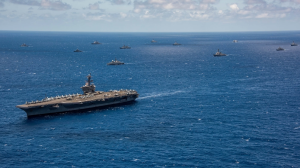Catherine Putz

In “To Rule The Waves,” Bruce Jones, director and a senior fellow in the Project on International Order and Strategy at the Brookings Institution, charts three geopolitical struggles playing out on the Earth’s oceans: increasing competition between the United States and China; the unceasing flow of global commerce; and the science of a changing climate.
These struggles, complex individually and inextricably intertwined, define the critical role of the world’s oceans in global power politics. In this interview with The Diplomat’s Managing Editor Catherine Putz, Jones summarizes the ways the key dynamics of global power – trade and military might – are shaped by the seas and the ways in which climate change will present both challenges and opportunities, complicating cooperation along the way.
The dynamics of global power – trade and military might – have been shaped for hundreds of years by the sea. What struggles are being played out on the oceans of today?
The oceans are a central zone for commercial competition, scientific collaboration, and naval rivalry. Sea-based trade is not just an element of globalization; it’s the core of it. Fully 85 percent of global trade moves by sea, and roughly two-thirds of the world’s supply of oil and gas is either found at sea or moves by sea to its final market. All of this underpins a mounting naval arms race, centered in the Western Pacific, but rapidly spreading to the Arctic, Indian, Atlantic, and Southern Oceans as well.
Can you elaborate on the ways in which oceans factor into growing China-U.S. tensions?
China is hugely dependent on the flow of commercial and energy goods in and out of its near seas and thus confronted by an ever-deepening version of its Malacca Dilemma: The more it grows, the more dependent it becomes on the role of the U.S. Navy in providing security for the oceanic flow of free trade and of energy. It’s an untenable position for China, and the PLAN has moved to increase its own capacity to secure shipping and solidify China’s position in the Yellow Sea, the East China Sea, and the South China Sea. But now, having established a strong position in those waters, it’s looking to protect its presence there from American and allied action from the Western Pacific. And the PLAN is establishing a presence and reach out to the western edges of the Indian Ocean. Meanwhile Russia has bolstered its presence in the Arctic, from where it reaches down into the North Atlantic. All of this makes the U.S. Navy, and the U.S. establishment, deeply uneasy, as it does the European and Asian allies. The result is, in short, a mounting, global naval arms race.
No comments:
Post a Comment